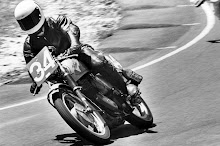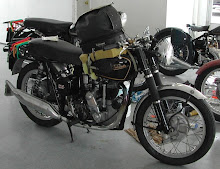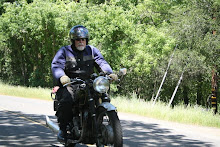It has generated interest over the intervening years and I've manufactured a few more as a result of the post.
so lets have another look at this instrument that carries this A.T coding...
They are characterised by the pointer rotating through a slot in the instrument dial with the pointer blade sweeping the surface of the dial rather than from completely above it as in other speedometers made by smiths and other manufacturers.
The A.T Speedometer Company Ltd of 140 Long Acre, London WC was advertising in "Flight" magazine in July 1915 so they are one of the originals in automotive,motorcycle and aviation instrumentation....
Their speedometers had been in Rolls Royce cars since the 1920's and in Bentley cars from around this time also....
Simon Roope, with who I have a correspondence has responded with some interesting, additional information in the comments section below but I've incorporated it here....thanks Simon...
The AT showroom was at 140 Long Acre before the Great War; an original 25 page AT Speedometer catalogue from 1912 I own has this address printed on each page.
From the early 1920s AT instruments were fitted to many prestige vintage cars, including Rolls Royce, Bentley and Frazer Nash. By then, manufacture of AT instruments had moved to West London and from October 1924 to 20 Avonmore Rd, London W14 (pg. 36, Motorsport, October 1924)
AT had German parentage (instrument manufacturers Deuta-Werke GmbH, Berlin) and under the newly formed Trading with the Enemy Act of 1914 company assets were confiscated at the outbreak of war. Ownership passed to Smiths, then to S.D Mckellen in 1920, and to Jaeger in December 1928 who in October the previous year had been bought by Smiths. In 1930 manufacture of AT instruments moved to the newly built Chronos Works. (pg. 82, James Nye's new book 'A Long Time in Making; History of Smiths' and pg. 42-44, 'Roadcraft' magazine published by Smiths for the 1937 London Olympia Motor Show).
In 1931 Bentley Motors went into liquidation and was acquired by Rolls Royce.
Two years later the first Rolls Royce made Bentley car (3 1/2 Litre saloon) went on sale. So in 1933 it is the model of car that is new not the fitting of AT instruments to Bentley cars; this had happened ten years earlier.
Lets have a peruse of a 1934 A.T. catalogue to view the items they made then.
Following are examples of car and lorry dashboards from around 1955 which utilise the A.T. versions Smiths made.
Smiths AT speedometer from a Leyland bus....
During 1964,1965 Smiths made industrial versions of the A.T. Tachometer available also....
As mentioned I did a posting in 2009 and this discusses the principle of operation of the A.T instrument and is useful to assist....
Finally, Smiths made hand held industrial tachometers to measure rotating shaft speeds etc and these of the A.T principle.....
They often had multiple scales altered by a knob on the case....
















































4 comments:
Dennis, thank you for the excellent blog post; I hope some additional detail will be of interest.
The AT showroom was at 140 Long Acre before the Great War; an original 25 page AT Speedometer catalogue from 1912 I own has this address printed on each page.
From the early 1920s AT instruments were fitted to many prestige vintage cars, including Rolls Royce, Bentley and Frazer Nash. By then, manufacture of AT instruments had moved to West London and from October 1924 to 20 Avonmore Rd, London W14 (pg. 36, Motorsport, October 1924)
AT had German parentage (instrument manufacturers Deuta-Werke GmbH, Berlin) and under the newly formed Trading with the Enemy Act of 1914 company assets were confiscated at the outbreak of war. Ownership passed to Smiths, then to S.D Mckellen in 1920, and to Jaeger in December 1928 who in October the previous year had been bought by Smiths. In 1930 manufacture of AT instruments moved to the newly built Chronos Works. (pg. 82, James Nye's new book 'A Long Time in Making; History of Smiths' and pg. 42-44, 'Roadcraft' magazine published by Smiths for the 1937 London Olympia Motor Show).
In 1931 Bentley Motors went into liquidation and was acquired by Rolls Royce. Two years later the first Rolls Royce made Bentley car (3 1/2 Litre saloon) went on sale. So in 1933 it is the model of car that is new not the fitting of AT instruments to Bentley cars; this had happened ten years earlier.
Regards
Simon, London
Hello I have got a very similar to the square Smiths AT Speedometer above, I believe also from a Layland vehicle. If anyone can please give me anymore info about it so I can sell it to the right collector or restorer and make someone happy. My e-mail is cdubweiser@googlemail.com if you want to get in touch for pictures.... thanks Chris
Hello I have got a very similar to the square Smiths AT Speedometer above, I believe also from a Layland vehicle. If anyone can please give me anymore info about it so I can sell it to the right collector or restorer and make someone happy. My e-mail is cdubweiser@googlemail.com if you want to get in touch for pictures.... thanks Chris
A most interesting article.
The white square-faced instruments shown were mainly fitted to Leyland commercial vehicles and were incorporated as part of the Smiths "Electromag" range of instruments. Usually fitted to Leyland mid-engined bus chassis which would have required horrendously long cables so the Electromag speedo/tacho used a three phase generator at the engine driving a three phase servomotor with the AT instrument as the readout in the cab. Smiths also had an "AT" range of cable driven instruments.
Post a Comment